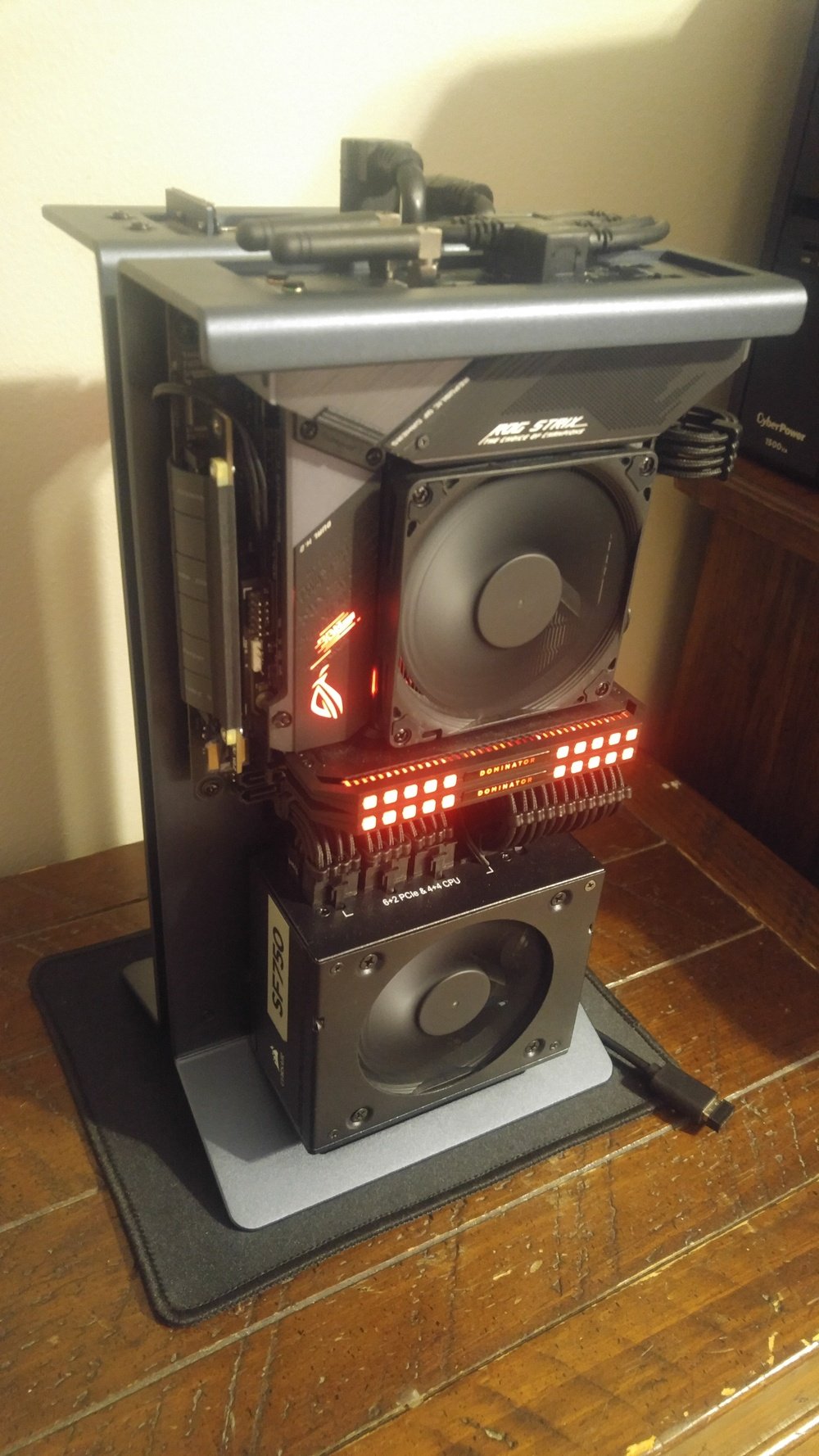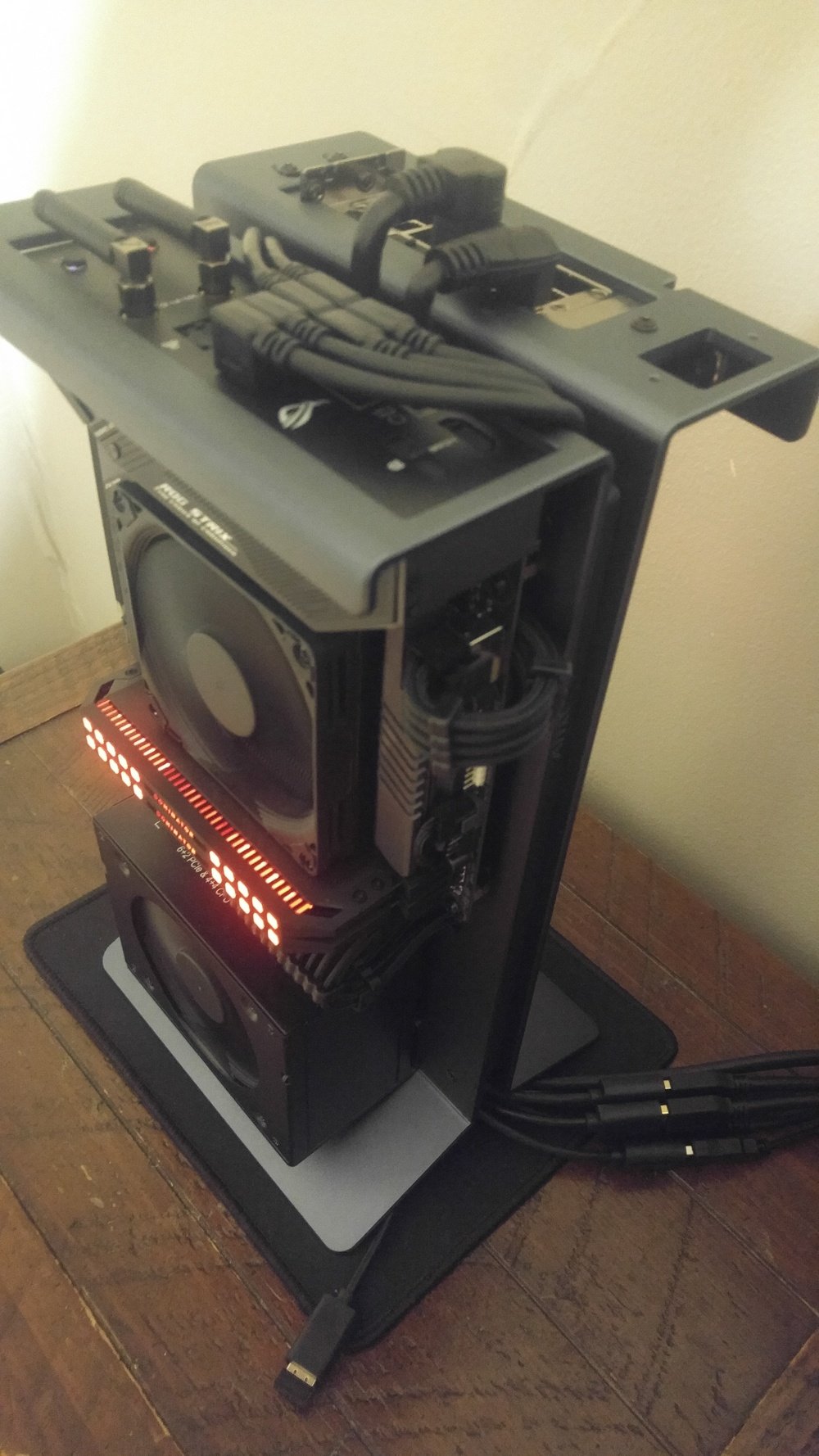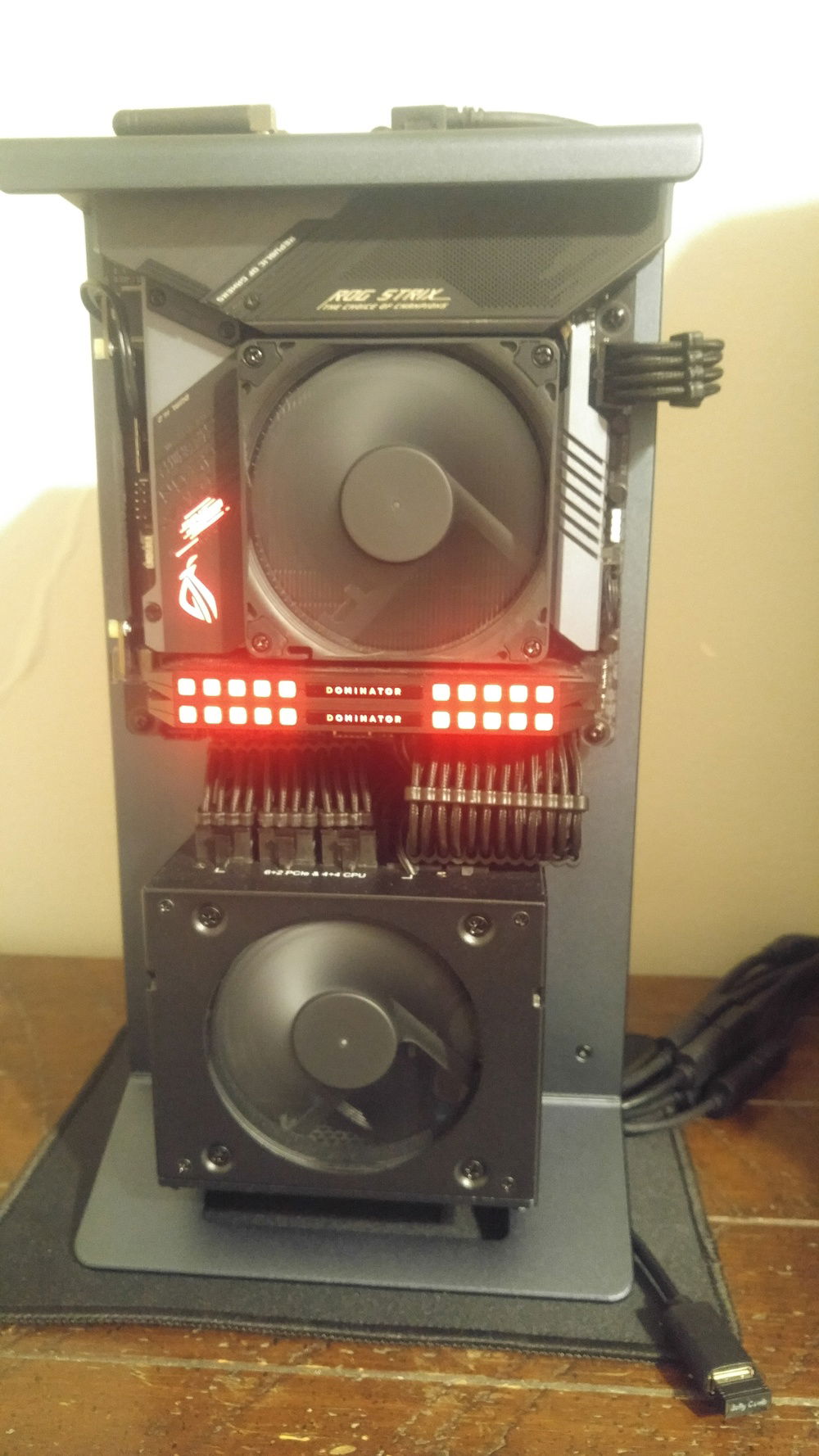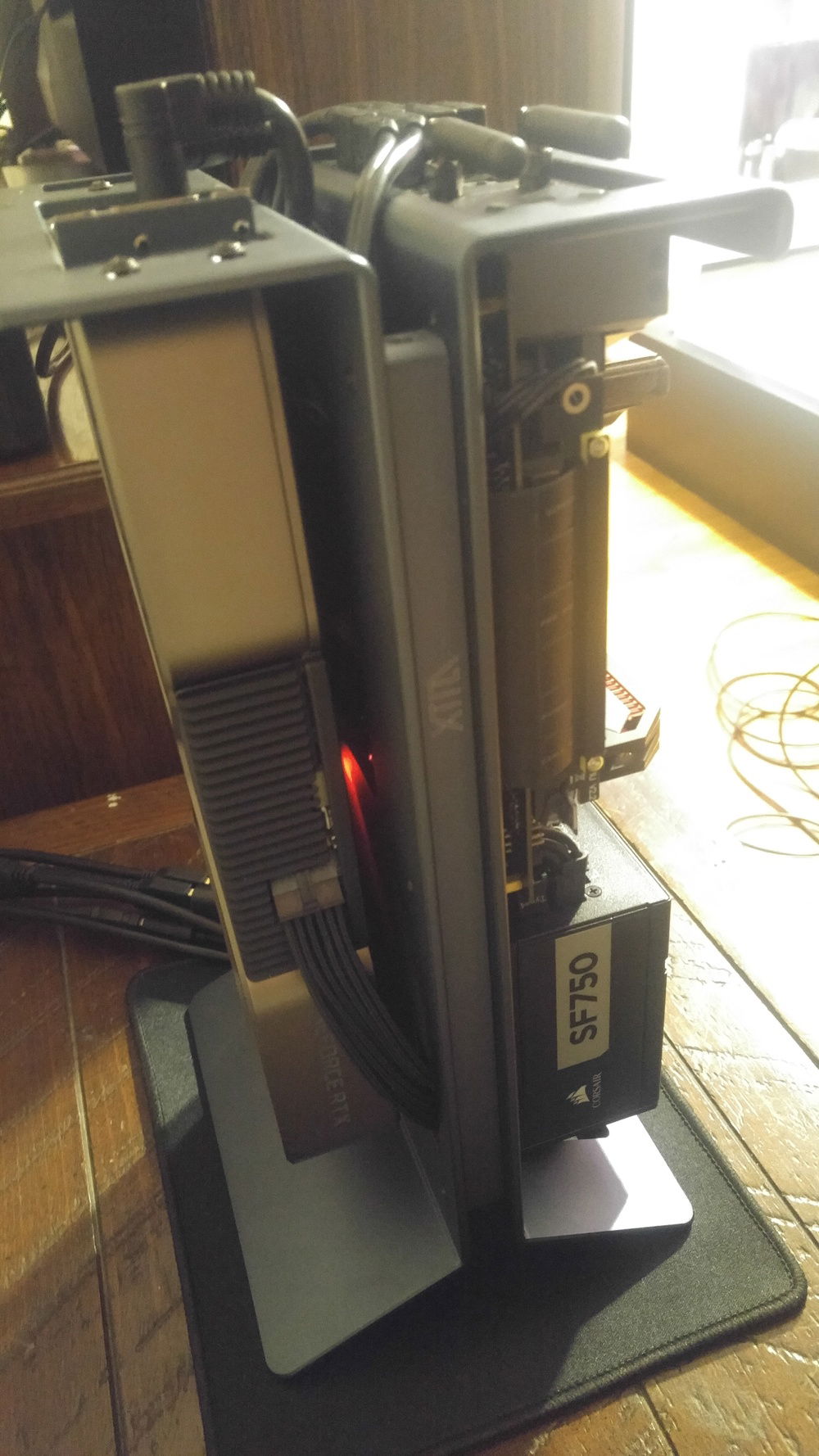Dusk | Aesthetically Focused | High Performance | Open Air | Silent | ITX Gaming PC
After 4 solid months of blood, sweat, tears and labor I'm finally finished with my first ITX build. I'd like to thank everyone who helped me along this journey for both the inspiration and assistance as well. My usual build methodology is function over form; this was my first attempt at doing the inverse which still feels odd to me. If you have any suggestions or comments, please feel free to let me know, thanks ~
Case: Xtia Xproto was chosen for it's combination of aesthetics and unmatched thermal performance for being an open air ITX case. With this case being the premise of this build, many compromises had to be made in order to not ruin the aesthetics, performance, or acoustics. I've always thought it was odd to call a PC a "Desktop" because they're usually too big to fit comfortably on a desk, thus I set out on this journey to change that. the Xproto has a insanely small footprint of only 6 by 8 inches. this makes it even smaller than a standard mousepad. Also since the Xproto is an open air case, the fans can be ran at very low and inaudible speeds while still keeping the hardware components adequately cooled. the biggest issue with the Xproto is the extremely slim amount of cable management room available. Even increasing this space by just a few millimeters would make a huge difference in ease of building while still maintaining the beautiful aesthetics.
CPU: Intel Core i5-10400 was chosen due to thermal limitations and also my desire for an iGPU incase there's an issue with the dedicated graphics card. This CPU will be replaced in March 2021 with the Intel Core i5-11400 for hopefully similar IPC gains as the AMD 5600x. At 1440p and 2160p the difference between the i5-10400 and the best CPUs out there is less than 5% which I'm glad isn't bothering me more having come from an AMD 3950x.
CPU Cooler: Noctua NH-L9i was chosen purely for aesthetic reasons. It has a nice low profile form factor and with a PWM BIOS fan curve tweak, it is extremely quiet and entirely inaudible during operation while still keeping CPU temps between 40-65c at all times even during gaming. In software such as premier pro or DaVinci resolve the CPU can reach 90c if using software encoding under 100% continuous load. For this reason, GPU hardware encoding (NVENC) is highly preferable since both CPU/GPU will run under 55c during this type of load.
Thermal Compound: Thermal Grizzly Kryonaut was initially chosen because of it's good performance but I switched to the included thermal compound that came with the Noctua cooler because it spreads much easier and I was getting better temperatures with it. I believe my motherboard, heatsink, or IHS isn't flat because I was having issues getting optimal spread on the IHS. After several remounts and the Noctua paste, temps dropped about 5-10c to where they should be. This is a 95TDP cooler with a 125TDP cpu (Not Optimal)
Motherboard: Asus ROG STRIX Z490-I was chosen purely for aesthetic reasons. Out of all the AMD and Intel ITX motherboards I thought that this one looked the most awesome. It seems odd to have paired a nearly $300 motherboard with a sub $200 CPU, but in my opinion it was worth it for the hyper clean aesthetic flow from the motherboard's heatsinks/m.2 mounts to the CPU heatsink and RAM heatsinks.
RAM: Corsair Dominator Platinum (2 x 8 GB) 3600Mhz CL18 was chosen for it's combination of aesthetics and value. I prefer light touches of RGB rather than overkill so this fit me perfectly. The faster ram models don't offer much more than an additional 1-2% FPS at an enormous price hike so I settled on 16gb 3600Mhz especially since DDR5 is right around the corner Q4 2021. During Heavy 4K gaming or even intense 4K OBS/Premier Pro usage, I've never ran out of ram, though I've been over 12gb a few times.
SSD: 2TB Sabrent Rocket 4.0 was chosen as a mass storage device because I often mess up windows and I wanted a safe physically separate drive from my operating system. Due to small clearance in the Xproto case, there was no extra room for a SATA SSD either.
SSD: 500gb Samsung 980 Pro was chosen for having 1 million IOPS and 7,000mbps when rocket lake CPUs are released for gen 4 pcie. Despite being wicked fast on paper, in practice it's no faster than any other NVME SSD from what I can tell. These high end NVME SSDs are over priced in my opinion but it's nice having very high TBW and write endurances for the added benefit of peace of mind. Oddly enough, my 980 PRO was performing very slow in synthetic benchmarks for the first day. I don't know what resolved the issue but others also said this was an issue for them as well.
GPU: Nvidia 3080 Founders edition was chosen because it's the best looking 2 slot 3080 available and it's also the cheapest. It's been extremely quiet on this open air case and usually runs around 60c or less while gaming under max load which amazes me. the only thing that bothers me is how hot it can get during idle. If MSI afterburner is running, the fans kick on super low speed and keep the idle temps around 31c however if MSI afterburner isn't running the ide temps can climb to 55-59c at which point the built in fan curve will sometimes trigger the fans to cool it down a bit. these idle temps are high because there is no case airflow over the gpu but I do not believe these idle temps are actually dangerous because the clock speeds, voltage, etc, are running at next to nothing. though, I do find it ironic that while gaming the GPU only gets about 4-5c warmer than it does at idle. Finally, I'd like to add that I was worried that the "flow through design" of the 2nd fan in the GPU would be an issue since it would be blowing hot air directly on to the closed off back side of the Xproto case, but from what I can tell it has not had any impact on the temps whatsoever. Xtia actually made cut outs in this area for this reason on the new "Xproto L" case but I doubt they actually lower GPU temps at all because there is still nowhere for that hot air to go inside of the case.
Power Supply: Corsair SF 750w was chosen because it offers the most amount of watts in the smallest size possible and it even comes with its own individually sleeved cables. Ironically this power supply was almost as hard to get at MSRP as the 3080FE was. I did a 92mm Noctua A9x14 HS-PWM fan swap with it because I couldn't stand the white corsair fan. I wired the Noctua fan directly to the motherboard using a PWM extension cable for several reasons. First off, all the guides claiming to have the proper pin outs and instructions to connect this fan directly to the PSU board, ARE FLAT OUT WRONG. I killed several fans as well as found out that even when wired "properly" the fan still would never come on even while under super heavy loads. I've asked many people who did this swap if they ever saw their fans come on and they all said "no" despite that the stock corsair fan would come on, so I highly suggest using a motherboard PWM header when doing this swap. Secondly, when connected directly to the motherboard, the Noctua fan can be set to always run silently thus cooling the PSU before it heats up rather than getting loud once the PSU is already overheating from a high load. I also removed the black PSU fan grill for aesthetic purposes.
Cable Combs: I used the cheap ones right on amazon and then double sided some of them back and front to prevent the cables from coming out of place. I may change these in the future to nicer plastic/metal ones but I haven't seen a lot of good options. If anyone has any suggestions, please let me know.
Angled USB 3.0 Cable Extensions: Now these were a real pain to finally hunt down and import from china over at AliExpress. the issue is that all of the other Angled USB 3.0 extenders on Amazon and in the USA are only 10-20cm long which is far too short to fit out of the bottom of the Xproto case.
Angled HDMI 2.1 Cable Extension: there was literally only one option to choose from and the ribbon cables are only HDMI 2.0. the only issue I had here is that after the built in 90 degree bend, the cable has to make a another very sharp 90 degree turn down into the case which has caused the rubber casing to crinkle up a bit upon itself; this appears as if it would damage it and cause the cable to stop working but nevertheless I've had no performance and the cable works exactly as intended with full bandwidth.
Angled Display Port 1.4 Cable Extension: The only alternative is a ribbon cable from china that I've ordered to replace this because it sticks up quite far and has the same issue as the angled HDMI extension. I did not want to run full length cables from this PC because it would no longer be portable without 10 foot cables coming out of the bottom. The end of the DP cable I'm using now just barely reached the bottom of the Xproto case so that I was able to zip tie it down so that it can be used like a mounted i/o port out of the bottom of the case. It actually turned out quite nice but a longer and flat ribbon cable would overall be better since it wouldn't have to bend so hard and it would leave more space inside the pc and would be easier to connect to without having to turn the pc on its side.
Antennas: SFF Noir Antennas turned out to be entirely useless and a complete placebo. they did not help with better Bluetooth nor Wi-Fi range so I may replace them. I chose them because they were small and low profile but functionally small antennas are awful. If anyone has some better suggestions to replace these, let me know.
Asiahorse RTX 3.0 Series Extension cable was chosen due to a lack of alternatives. I was worried that 18AWG would melt on a 3080 like several 3090 owners reported but even under full load the cables only felt warm to the touch and did not affect performance in any kind of way. CableMod does offer a proper 16AWG cable but not only is it extremely expensive but shipping was 2-3 months on it. Also it's impossible to cable combo these 12 wires since they are crammed so close to each other.
I/O Dust Plugs: I used a bunch of these from Amazon mostly for aesthetic purposes but also because it's impossible to turn off the RED GREEN BLUE LED lights on the motherboard audio jacks. These can be used to block those lights.
Maintenance: I use a small paintbrush and blower to dust the PC. MSI afterburner is my go to for monitoring temps.
Case: Xtia Xproto was chosen for it's combination of aesthetics and unmatched thermal performance for being an open air ITX case. With this case being the premise of this build, many compromises had to be made in order to not ruin the aesthetics, performance, or acoustics. I've always thought it was odd to call a PC a "Desktop" because they're usually too big to fit comfortably on a desk, thus I set out on this journey to change that. the Xproto has a insanely small footprint of only 6 by 8 inches. this makes it even smaller than a standard mousepad. Also since the Xproto is an open air case, the fans can be ran at very low and inaudible speeds while still keeping the hardware components adequately cooled. the biggest issue with the Xproto is the extremely slim amount of cable management room available. Even increasing this space by just a few millimeters would make a huge difference in ease of building while still maintaining the beautiful aesthetics.
CPU: Intel Core i5-10400 was chosen due to thermal limitations and also my desire for an iGPU incase there's an issue with the dedicated graphics card. This CPU will be replaced in March 2021 with the Intel Core i5-11400 for hopefully similar IPC gains as the AMD 5600x. At 1440p and 2160p the difference between the i5-10400 and the best CPUs out there is less than 5% which I'm glad isn't bothering me more having come from an AMD 3950x.
CPU Cooler: Noctua NH-L9i was chosen purely for aesthetic reasons. It has a nice low profile form factor and with a PWM BIOS fan curve tweak, it is extremely quiet and entirely inaudible during operation while still keeping CPU temps between 40-65c at all times even during gaming. In software such as premier pro or DaVinci resolve the CPU can reach 90c if using software encoding under 100% continuous load. For this reason, GPU hardware encoding (NVENC) is highly preferable since both CPU/GPU will run under 55c during this type of load.
Thermal Compound: Thermal Grizzly Kryonaut was initially chosen because of it's good performance but I switched to the included thermal compound that came with the Noctua cooler because it spreads much easier and I was getting better temperatures with it. I believe my motherboard, heatsink, or IHS isn't flat because I was having issues getting optimal spread on the IHS. After several remounts and the Noctua paste, temps dropped about 5-10c to where they should be. This is a 95TDP cooler with a 125TDP cpu (Not Optimal)
Motherboard: Asus ROG STRIX Z490-I was chosen purely for aesthetic reasons. Out of all the AMD and Intel ITX motherboards I thought that this one looked the most awesome. It seems odd to have paired a nearly $300 motherboard with a sub $200 CPU, but in my opinion it was worth it for the hyper clean aesthetic flow from the motherboard's heatsinks/m.2 mounts to the CPU heatsink and RAM heatsinks.
RAM: Corsair Dominator Platinum (2 x 8 GB) 3600Mhz CL18 was chosen for it's combination of aesthetics and value. I prefer light touches of RGB rather than overkill so this fit me perfectly. The faster ram models don't offer much more than an additional 1-2% FPS at an enormous price hike so I settled on 16gb 3600Mhz especially since DDR5 is right around the corner Q4 2021. During Heavy 4K gaming or even intense 4K OBS/Premier Pro usage, I've never ran out of ram, though I've been over 12gb a few times.
SSD: 2TB Sabrent Rocket 4.0 was chosen as a mass storage device because I often mess up windows and I wanted a safe physically separate drive from my operating system. Due to small clearance in the Xproto case, there was no extra room for a SATA SSD either.
SSD: 500gb Samsung 980 Pro was chosen for having 1 million IOPS and 7,000mbps when rocket lake CPUs are released for gen 4 pcie. Despite being wicked fast on paper, in practice it's no faster than any other NVME SSD from what I can tell. These high end NVME SSDs are over priced in my opinion but it's nice having very high TBW and write endurances for the added benefit of peace of mind. Oddly enough, my 980 PRO was performing very slow in synthetic benchmarks for the first day. I don't know what resolved the issue but others also said this was an issue for them as well.
GPU: Nvidia 3080 Founders edition was chosen because it's the best looking 2 slot 3080 available and it's also the cheapest. It's been extremely quiet on this open air case and usually runs around 60c or less while gaming under max load which amazes me. the only thing that bothers me is how hot it can get during idle. If MSI afterburner is running, the fans kick on super low speed and keep the idle temps around 31c however if MSI afterburner isn't running the ide temps can climb to 55-59c at which point the built in fan curve will sometimes trigger the fans to cool it down a bit. these idle temps are high because there is no case airflow over the gpu but I do not believe these idle temps are actually dangerous because the clock speeds, voltage, etc, are running at next to nothing. though, I do find it ironic that while gaming the GPU only gets about 4-5c warmer than it does at idle. Finally, I'd like to add that I was worried that the "flow through design" of the 2nd fan in the GPU would be an issue since it would be blowing hot air directly on to the closed off back side of the Xproto case, but from what I can tell it has not had any impact on the temps whatsoever. Xtia actually made cut outs in this area for this reason on the new "Xproto L" case but I doubt they actually lower GPU temps at all because there is still nowhere for that hot air to go inside of the case.
Power Supply: Corsair SF 750w was chosen because it offers the most amount of watts in the smallest size possible and it even comes with its own individually sleeved cables. Ironically this power supply was almost as hard to get at MSRP as the 3080FE was. I did a 92mm Noctua A9x14 HS-PWM fan swap with it because I couldn't stand the white corsair fan. I wired the Noctua fan directly to the motherboard using a PWM extension cable for several reasons. First off, all the guides claiming to have the proper pin outs and instructions to connect this fan directly to the PSU board, ARE FLAT OUT WRONG. I killed several fans as well as found out that even when wired "properly" the fan still would never come on even while under super heavy loads. I've asked many people who did this swap if they ever saw their fans come on and they all said "no" despite that the stock corsair fan would come on, so I highly suggest using a motherboard PWM header when doing this swap. Secondly, when connected directly to the motherboard, the Noctua fan can be set to always run silently thus cooling the PSU before it heats up rather than getting loud once the PSU is already overheating from a high load. I also removed the black PSU fan grill for aesthetic purposes.
Cable Combs: I used the cheap ones right on amazon and then double sided some of them back and front to prevent the cables from coming out of place. I may change these in the future to nicer plastic/metal ones but I haven't seen a lot of good options. If anyone has any suggestions, please let me know.
Angled USB 3.0 Cable Extensions: Now these were a real pain to finally hunt down and import from china over at AliExpress. the issue is that all of the other Angled USB 3.0 extenders on Amazon and in the USA are only 10-20cm long which is far too short to fit out of the bottom of the Xproto case.
Angled HDMI 2.1 Cable Extension: there was literally only one option to choose from and the ribbon cables are only HDMI 2.0. the only issue I had here is that after the built in 90 degree bend, the cable has to make a another very sharp 90 degree turn down into the case which has caused the rubber casing to crinkle up a bit upon itself; this appears as if it would damage it and cause the cable to stop working but nevertheless I've had no performance and the cable works exactly as intended with full bandwidth.
Angled Display Port 1.4 Cable Extension: The only alternative is a ribbon cable from china that I've ordered to replace this because it sticks up quite far and has the same issue as the angled HDMI extension. I did not want to run full length cables from this PC because it would no longer be portable without 10 foot cables coming out of the bottom. The end of the DP cable I'm using now just barely reached the bottom of the Xproto case so that I was able to zip tie it down so that it can be used like a mounted i/o port out of the bottom of the case. It actually turned out quite nice but a longer and flat ribbon cable would overall be better since it wouldn't have to bend so hard and it would leave more space inside the pc and would be easier to connect to without having to turn the pc on its side.
Antennas: SFF Noir Antennas turned out to be entirely useless and a complete placebo. they did not help with better Bluetooth nor Wi-Fi range so I may replace them. I chose them because they were small and low profile but functionally small antennas are awful. If anyone has some better suggestions to replace these, let me know.
Asiahorse RTX 3.0 Series Extension cable was chosen due to a lack of alternatives. I was worried that 18AWG would melt on a 3080 like several 3090 owners reported but even under full load the cables only felt warm to the touch and did not affect performance in any kind of way. CableMod does offer a proper 16AWG cable but not only is it extremely expensive but shipping was 2-3 months on it. Also it's impossible to cable combo these 12 wires since they are crammed so close to each other.
I/O Dust Plugs: I used a bunch of these from Amazon mostly for aesthetic purposes but also because it's impossible to turn off the RED GREEN BLUE LED lights on the motherboard audio jacks. These can be used to block those lights.
Maintenance: I use a small paintbrush and blower to dust the PC. MSI afterburner is my go to for monitoring temps.
Color(s): Black
RGB Lighting? Yes
Theme: none
Cooling: Air Cooling
Size: SFF
Type: General Build
Contests
This build participated in 1 contest.
| Rank | Contest | Date |
|---|---|---|
| #57 | SFFPC meets builds.gg Contest | ended |
Hardware
CPU
$ 169.95
Motherboard
$ 499.00
Memory
$ 252.19
Graphics
$ 699.99
Storage
$ 249.99
Case Fan
$ 23.95
Cooling
$ 49.99
Estimated total value of this build:
$ 2,485.05
Approved by:



